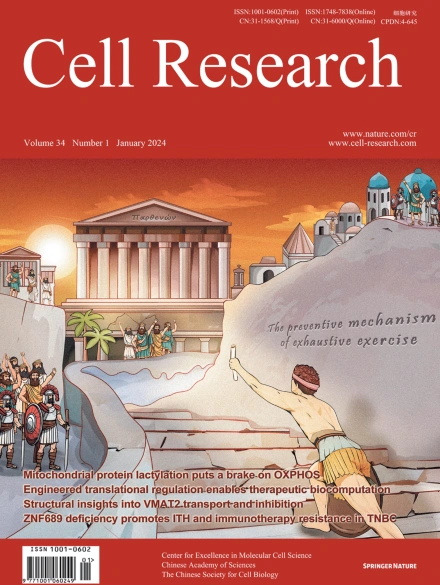
Advanced Search
Submit Manuscript
Advanced Search
Submit Manuscript
Volume 34, No 1, Jan 2024
ISSN: 1001-0602
EISSN: 1748-7838 2018
impact factor 17.848*
(Clarivate Analytics, 2019)
Volume 34 Issue 1, January 2024: 47-57 |
Transport and inhibition mechanism for VMAT2-mediated synaptic vesicle loading of monoamines
Yuwei Wang1,2,† , Pei Zhang3,† , Yulin Chao1,2,† , Zhini Zhu1,2,† , Chuanhui Yang1,2,† , Zixuan Zhou1,2,† , Yaohui Li1,2 , Yonghui Long1,2 , Yuehua Liu1 , Dianfan Li3 , Sheng Wang3,4,* , Qianhui Qu1,2,*
1Shanghai Stomatological Hospital, School of Stomatology, Institutes of Biomedical Sciences, Fudan University, Shanghai, ChinaMonoamine neurotransmitters such as serotonin and dopamine are loaded by vesicular monoamine transporter 2 (VMAT2) into synaptic vesicles for storage and subsequent release in neurons. Impaired VMAT2 function underlies various neuropsychiatric diseases. VMAT2 inhibitors reserpine and tetrabenazine are used to treat hypertension, movement disorders associated with Huntington’s Disease and Tardive Dyskinesia. Despite its physiological and pharmacological significance, the structural basis underlying VMAT2 substrate recognition and its inhibition by various inhibitors remains unknown. Here we present cryo-EM structures of human apo VMAT2 in addition to states bound to serotonin, tetrabenazine, and reserpine. These structures collectively capture three states, namely the lumen-facing, occluded, and cytosol-facing conformations. Notably, tetrabenazine induces a substantial rearrangement of TM2 and TM7, extending beyond the typical rocker-switch movement. These functionally dynamic snapshots, complemented by biochemical analysis, unveil the essential components responsible for ligand recognition, elucidate the proton-driven exchange cycle, and provide a framework to design improved pharmaceutics targeting VMAT2.
https://doi.org/10.1038/s41422-023-00906-z